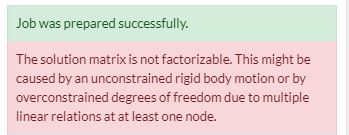I started over with the CAD model, this time I made a left/right symmetry plane and I am using only a 1/4 envelope shape and I increased my CAD file precision to 5e-07 meters, that should be fine enough to take any precision concerns away (it was 5e-05 meters on the original model).
I created a new project for this and the ‘Static 1 Nonlinear’ simulation with following pressure which I am trying to run.
Unfortunately I can not understand why the simulation error seems to think I have not properly constrained this new model geometry, can someone have a look? Here is the error for ‘Run 1’:
Also, I added gravity to the sim setup in the ‘Model’ parameter. I think I have done that correctly but I can find no information in the Docs about when to use Linear vs Nonlinear Gravity, can you enlighten me?
It also seems strange that the default valued 1/4 envelope mesh is 1.6M cells vs the 1/2 envelopes 0.7M cells, is this strange or is it due to some meshing defaults different between static and dynamic simulations?
Again sorry for having problems with these basic issues…
Dale
